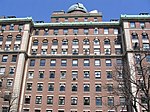Columbia Business School
1916 establishments in New York CityBusiness schools in New York (state)Columbia Business SchoolColumbia UniversityEducational institutions established in 1916 ... and 4 more
Ivy League business schoolsUniversities and colleges in ManhattanUniversities and colleges in New York CityUse mdy dates from March 2020
Columbia Business School (CBS) is the business school of Columbia University, a private research university in New York City. Established in 1916, Columbia Business School is one of six Ivy League business schools and is one of the oldest business schools in the world. Although it originally offered undergraduate degrees, it stopped doing so in the middle of the twentieth century and now only offers graduate degrees and professional programs.
Excerpt from the Wikipedia article Columbia Business School (License: CC BY-SA 3.0, Authors).Columbia Business School
Low Library Steps, New York Manhattan
Geographical coordinates (GPS) Address Website Nearby Places Show on map
Geographical coordinates (GPS)
| Latitude | Longitude |
|---|---|
| N 40.80998 ° | E -73.96096 ° |
Address
Columbia University (Columbia University in the City of New York)
Low Library Steps
10027 New York, Manhattan
New York, United States
Open on Google Maps





